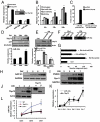Neuronal differentiation by TAp73 is mediated by microRNA-34a regulation of synaptic protein targets
- PMID: 22160687
- PMCID: PMC3248477
- DOI: 10.1073/pnas.1112061109
Neuronal differentiation by TAp73 is mediated by microRNA-34a regulation of synaptic protein targets
Abstract
The p53-family member TAp73 is a transcription factor that plays a key role in many biological processes. Here, we show that p73 drives the expression of microRNA (miR)-34a, but not miR-34b and -c, by acting on specific binding sites on the miR-34a promoter. Expression of miR-34a is modulated in parallel with that of TAp73 during in vitro differentiation of neuroblastoma cells and cortical neurons. Retinoid-driven neuroblastoma differentiation is inhibited by knockdown of either p73 or miR-34a. Transcript expression of miR-34a is significantly reduced in vivo both in the cortex and hippocampus of p73(-/-) mice; miR-34a and TAp73 expression also increase during postnatal development of the brain and cerebellum when synaptogenesis occurs. Accordingly, overexpression or silencing of miR-34a inversely modulates expression of synaptic targets, including synaptotagmin-1 and syntaxin-1A. Notably, the axis TAp73/miR-34a/synaptotagmin-1 is conserved in brains from Alzheimer's patients. These data reinforce a role for TAp73 in neuronal development.
Conflict of interest statement
The authors declare no conflict of interest.
Figures




References
-
- Müller M, et al. TAp73/Delta Np73 influences apoptotic response, chemosensitivity and prognosis in hepatocellular carcinoma. Cell Death Differ. 2005;12:1564–1577. - PubMed
-
- Wang J, et al. TAp73 is a downstream target of p53 in controlling the cellular defense against stress. J Biol Chem. 2007;282:29152–29162. - PubMed
-
- Grob T-J, et al. Human delta Np73 regulates a dominant negative feedback loop for TAp73 and p53. Cell Death Differ. 2001;8:1213–1223. - PubMed
-
- Yang A, et al. p73-deficient mice have neurological, pheromonal and inflammatory defects but lack spontaneous tumours. Nature. 2000;404:99–103. - PubMed
-
- De Laurenzi V, et al. Induction of neuronal differentiation by p73 in a neuroblastoma cell line. J Biol Chem. 2000;275:15226–15231. - PubMed
Publication types
MeSH terms
Substances
Grants and funding
LinkOut - more resources
Full Text Sources
Other Literature Sources
Molecular Biology Databases
Research Materials
Miscellaneous

